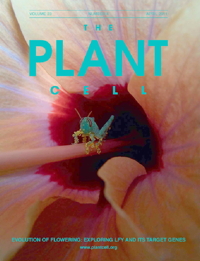| |
Sayou C, Nanao MH, Jamin M, Posé D, Thévenon E, Grégoire L, Tichtinsky G, Denay G, Ott F, Peirats Llobet M, Schmid M, Dumas R and Parcy F
A SAM oligomerization domain shapes the genomic binding landscape of the LEAFY transcription factor.
Nature Communications 2016,
7: 11222
Abstract -
Reprint -
Press release
3D pictures of LEAFY | |
 |
| | | | |
| |
Sayou C, Monniaux M, Nanao MH, Moyroud E, Brockington SF, Thévenon E, Chahtane H, Warthmann N, Melkonian M, Zhang Y, Wong GK, Weigel D, Parcy F and Dumas R
A promiscuous intermediate underlies the evolution of LEAFY DNA binding specificity.
Science, 2014,
343(6171): 645-648
Abstract -
Reprint -
Press release
Videos of LEAFY | |
 |
| | | | |
| |
Benlloch R, Kim MC, Sayou C, Thévenon E, Parcy F and Nilsson O
Integrating long-day flowering signals: A LEAFY binding site is essential for proper photoperiodic activation of APETALA1.
Plant Journal, 2011,
67(6): 1094-1102 | | |
| | | | |
 | |
Moyroud E, Minguet EG, Ott F, Yant L, Posé D, Monniaux M, Blanchet S, Bastien O, Thévenon E, Weigel D, Schmid M and Parcy F
Prediction of regulatory interactions from genome sequences using a biophysical model for the
Arabidopsis LEAFY transcription factor.
Plant Cell, 2011,
23(4): 1293-1306 | |
 |
| | | | |
| |
Moyroud E, Kusters E, Monniaux M, Koes R and Parcy F
LEAFY blossoms.
Trends in Plant Sciences, 2010,
15(6): 346-352
Moyroud E, Reymond MCA, Hamès C, Parcy F and Scutt CP
The Analysis of Entire Gene Promoters by Surface Plasmon Resonance.
Plant Journal, 2009,
59(5) : 851 – 858 | | |
| | | | |
| |
Hamès C, Ptchelkine D, Grimm C, Thevenon E, Moyroud E, Gérard F, Martiel JL, Benlloch R, Parcy F, Müller CW
Structural basis for LEAFY floral switch function and similarity with helix-turn-helix proteins.
The EMBO Journal, 2008,
27(19): 2628-2637 | |
 |